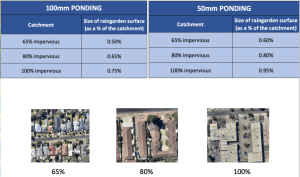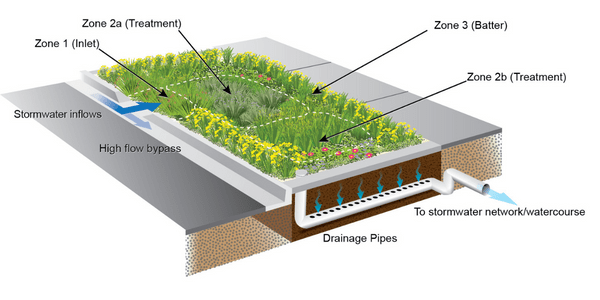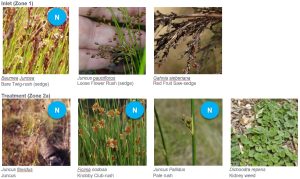- Is there suitable space (area available) to achieve the required stormwater treatment? Refer to Tip 2 for biofilter size guide rule of thumb relative to contributing catchment area. If contributing catchment area is too large, consider relocating the raingarden further up the catchment or be willing to accept a lower level of treatment.
- Is there an opportunity to integrate the raingarden with traffic management devices? Traffic protuberances designed in conjunction with a raingarden can deliver an asset with multiple benefits.
 Rankine Road, Torrensville – raingarden with traffic calming device. Source: City of West Torrens
Rankine Road, Torrensville – raingarden with traffic calming device. Source: City of West Torrens
- Is there a conflict with underground services in the proposed raingarden location? If so consider:
- A conduit through the raingarden
- Benching around the service.
- What if there is no underground stormwater drainage network?
- No underground drainage network = overflow weir in kerb instead of overflow structure
A system without an underground drainage system, a raingarden, would fill and spill at the street and gutter level, or near to that. Overflow structures are not required as there is not overflow. - Raingarden overflow weir in kerb

Stephens Avenue, Underdale raingarden. Source: Water Sensitive SA
- No underground drainage network = overflow weir in kerb instead of overflow structure
- Is there a potential trip (drop off ) hazard for pedestrians at the edge of a streetscape raingarden? If so, create a hard edging to define the raingarden boundary or install bench seating at edge of raingarden as a barrier.

Murchison Street, Woodville Gardens – raingarden with concrete bench barrier. Source: Water Sensitive SA
TIP 2 – Area of biofilter versus area of contributing catchment (for Adelaide)
- Rule of thumb

Source: Design Flow – Streetscape raingardens, design and practice course, 2022
- If the catchment is too large, the raingarden may be overloaded with too much sediment for its size. Normally the raingarden should be 0.5-1.0% of the catchment area.
TIP 3 – When should you include an impervious liner for your raingarden in Adelaide’s climate?
Almost always. Due to the long periods without rainfall over summer, a raingarden design should almost always include an impervious liner to ensure there is a reservoir of water to sustain the raingarden plants between rainfall events. The exception is a raingarden constructed in naturally sandy soils that has been designed to infiltrate to manage stormwater volumes. In these circumstances, plant species that are extremely drought tolerant will need to be chosen.
Liner options
- Plastic – 1.5mm (minimum) HDPE or other robust plastic, with welded joints to accommodate the raingarden profile. Designed to avoid perforations.
- Bentonite blankets – a sodium bentonite composite bonded between non-woven geotextile fabric layers.
- Clay
- 150-300mm of compacted clay
- if a saturated zone is required should achieve 1 x 10-9 m/s, otherwise 1 x 10-8 m/s is suitable
- It is recommended to seek geotechnical advice.
Source: Design Flow – Streetscape raingardens – design and practice course, 2022
TIP 4 – Inlet design
Streetscape raingarden inlets should be designed to:
- Ensure the rate of inflows can achieve the design storm of 0.5 x Q1 (annual exceedance probability [AEP] 63.21).
- Ensure there is sufficient width of opening, minimum 500mm.
- Allow for pollutant deposition at the inlet and a means to remove it, including:
- a smooth surface finish on the apron to ensure any trapped sediment can readily be removed with a shovel
- rocks, or similar, to line the edges of the inlet to assist trapping of sediment
- tight stemmed vegetation planted around the perimeter of the inlet apron to trap litter and sediments from entering the filter media area. Refer to plant species in Zone 1 in A guide to raingarden plant species selection and placement PDF.
- Avoid scour (erosion control).
TIP 5 – Filter media
The filter media of biofiltration systems should be constructed in accordance with CRC for Water Sensitive Cities 2015 Adoption guidelines for stormwater biofiltration systems: Cities as water supply catchments – sustainable technologies, reproduced as follows:
- a very small amount of clay (up to 3%)
- organic matter (up to 5%) to the top layer of soil to retain moisture between rainfall events
- filter media required particle size distribution (PSD) ranges in accordance with Facility for Advancing Water Biofiltration (FAWB) guidelines:
- less than 3-5% fines (0.05mm)
- most particles around 0.2-1.0mm (60-80%)
- table below provides full filter media PSD
(% W/W) Retained Clay & silt <3% (<0.05mm) Very fine sand 5-30% (0.05-0.15mm) Fine sand 10-30% (0.15-0.25mm) Medium sand 40-60% (0.25-0.5mm) Coarse sand <25% (0.5-1.0mm) Very coarse sand 0-10% (1.0-2.0mm) Fine gravel <3% (2.0-3.4MM)
TIP 6 – Extended detention depth
Extended detention depth should be in the range of 100-300mm.
TIP 7 – Plant selection and placement:
The same care and consideration to plant species selection should be given to raingardens as for traditional landscaped areas.
A guide to raingarden plant species selection and placement PDF provides information on suitable species that will remove nitrogen from stormwater at the required rates.
For your raingarden to adequately filter stormwater, at least 50% of your raingarden’s plants must be effective at nitrogen removal. Use our planting guide PDF for ideas. Also provided are a range of suitable companion (aesthetic) plant species for the filter media area that can thrive in the raingarden’s wetting and drying cycles. In addition, the guide provides suggested plant species suitable for the batters and around the inlet apron.

Raingarden. Source: Water Sensitive SA
Raingarden planting palette fact sheet
Choosing plants with a variety of colours and shapes will enhance the overall amenity of the project. Our Raingarden planting palette PDF fact sheet provides a sample raingarden plant lists for a range of design objectives including:
- colourful species to attract birds and butterflies
- neutral colours
- spiky-looking species to suit an architectural setting
- indigenous flowering raingarden.

Example from the Raingarden planting palette fact sheet. Source: Water Sensitive SA
TIP 8 – Rock mulch should be avoided wherever possible
Equally, organic mulch is not recommended as it will wash away in storm events and can clog your biofiltration system.





